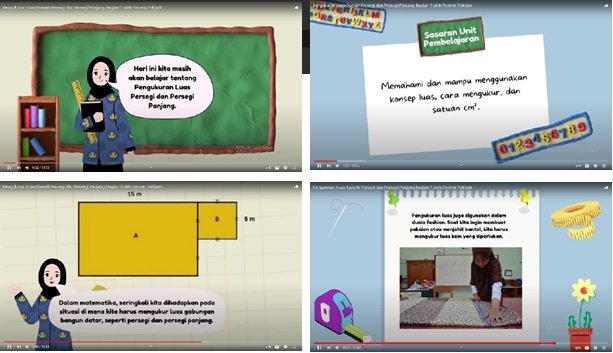Elementary School Teachers' Perceptions on Video-Based Mathematics Learning in Flipped Classroom Model towards Learning Quality
DOI:
https://doi.org/10.25217/numerical.v7i1.3462Keywords:
Flipped Classroom, Teachers Perceptions, Quality Learning, Video-Based MathematicsAbstract
Teachers' perceptions of video-assisted mathematics instruction in measurement topics within flipped classroom learning models vary. This study explores teachers' perceptions of using video-assisted mathematics instruction in measurement topics in elementary schools. A case study was conducted with 30 elementary school teachers teaching in various regions in Tasikmalaya. Data collection was carried out through questionnaire dissemination and interviews as research instruments. The data analysis technique employed in this study was Interactive Analysis, which involved data reduction, data presentation, and conclusion. The research findings indicate that teachers' perceptions of video-assisted mathematics instruction encompassed cognitive aspects with an average score of 87.50%, affective aspects with an average score of 88.50% and psychomotor aspects with an average score of 89.50%. The results show that most teachers positively perceive using video-assisted mathematics instruction in measurement topics. Teachers state that video-assisted instruction helps students understand measurement concepts and makes learning more engaging and enjoyable for elementary school students.
References
Bokhove, C., & Drijvers, P. (Eds.). (2017). Digital Technology in Mathematics Education: Why it Works (or Doesn't). Springer.
Lehrer, R., & Chazan, D. (Eds.). (2021). Video Research in Mathematics Education. Routledge.
Lage, M. J., Platt, G. J., & Treglia, M. (2000). Inverting the Classroom: A Gateway to Creating an Inclusive Learning Environment. The Journal of Economic Education, 31(1), 30-43.
Chen, C. H., Wang, C. H., & Lin, Y. L. (2014). The Effects of the Flipped Classroom Approach on Student Mathematics Achievement, Engagement and Self-Efficacy. Journal of Interactive Learning Research, 25(1), 97-117.
Cohen, D. K., McLaughlin, M. W., & Talbert, J. E. (2013). Teaching for understanding: Challenges for policy and practice. John Wiley & Sons.
Yusuf, M. O., Adelabu, M. A., & Salau, M. A. (2015). Teachers' Perception of the Effectiveness of Video Instruction on Students' Performance in Mathematics. American Journal of Educational Research, 3(4), 478-483.
Isnaini, S. N., Firman, & Desyandri. (2023). Penggunaan Media Video Pembelajaran dalam Meningkatkan Minat Belajar Matematika Siswa di Sekolah Dasar. ALPEN: Jurnal Pendidikan Dasar, 7(1), 1-10.
Abdulmajid, A. (2016). Analisis kualitas video pembelajaran matematika dan persepsi guru terhadap penggunaannya di SMA. Jurnal Pendidikan Matematika, 1(2), 11-22.
Sudjana, D., & Fitriani, H. (2019). Development of mathematics video learning media on measurement material using comic animation for elementary school students. Journal of Physics: Conference Series, 1317(1), 012033.
Apriansyah, M. F., & Pujiastuti, H. (2020). Pengembangan Bahan Ajar Matematika berbasis Virtual Learning dengan Gnomio. Jurnal Pendidikan Matematika, 11(2), 179–188. https://doi.org/http://dx.doi.org/10.36709/jpm.v11i2.11921.
Suwardi, S., Sutama, S., Yulia Maftuhah Hidayati, Y.M.H., Laili Etika Rahmawati, L.E.R. (2021). Pembelajaran pecahan melalui video: apakah dapat meningkatkan keaktifan dan prestasi siswa. PYTHAGORAS: Jurnal Pendidikan Matematika, 16(2), 163-173.
Siti-Madihah, A. R., & Kamisah, O. (2019). The effect of video-based tasks on reading comprehension performance among English as a foreign language (EFL) learners. Journal of Applied Research in Education, 23(1), 1-10.
Widoyoko, E. P. (2009). Evaluasi Program Pembelajaran. Yogyakarta: Pustaka Pelajar.
Kurniawan, I. T., & Darmaji. (2017). Pengaruh Penggunaan Media Video Pembelajaran Terhadap Hasil Belajar IPA Siswa SD Negeri 01 Taman. Jurnal PGSD Universitas Pendidikan Ganesha, 5(1), 23-30.
Handayani, L., & Yuliati, L. (2018). The Effectiveness of Video as an Audio-Visual Media in English Speaking Skill. The Asian EFL Journal Quarterly, 20(1), 197-208.
Rahmawati, A., & Wijayanti. D., (2020). Pengembangan Video Pembelajaran Fungsi Komposisi Sebagai Alternatif Bahan Ajar Untuk Meningkatkan Kemampuan Penalaran Matematis. Journal Pendidikan Matematika JUPITEK, 3(02), 57–64. DOI https://doi.org/10.30598/jupitekvol3iss2pp57-64.
Lee, H., & Choi, S. (2018). Analyzing the design elements of video lectures in Korean online higher education. International Journal of Information and Education Technology, 8(2), 139-142.
Kurniasari, D., & Astalini, A. (2020). Using video as a learning media to increase students' understanding in learning chemistry. Journal of Physics: Conference Series, 1462(1), 012044. doi: 10.1088/1742-6596/1462/1/012044.
Nurdianti, F., & Fauzi, A. (2018). Pengaruh Penggunaan Media Audio Visual Terhadap Motivasi Belajar Siswa Kelas VIII di SMPN 2 Sungai Raya. Jurnal Kreatif Tadulako Online, 6(2), 123-132.
Murtikusuma, R. (2019). Improving the practical skills of students through the use of video media in physics learning. Journal of Physics: Conference Series, 1157(4), 042058. doi: 10.1088/1742-6596/1157/4/042058

Downloads
Published
How to Cite
Issue
Section
License
Copyright (c) 2023 Zenzen Zakiyah Zen

This work is licensed under a Creative Commons Attribution-ShareAlike 4.0 International License.






